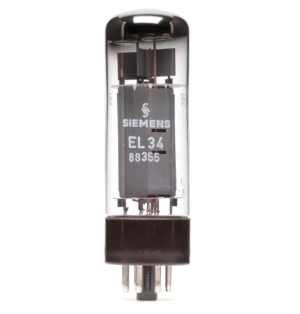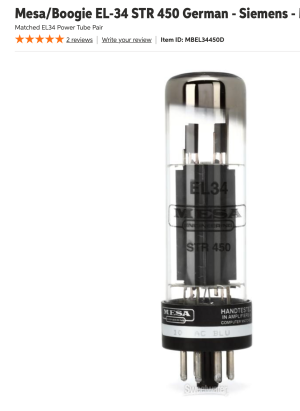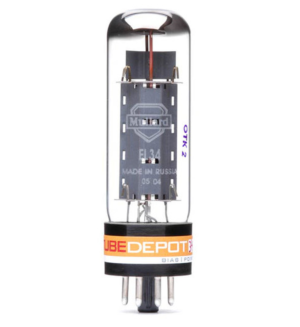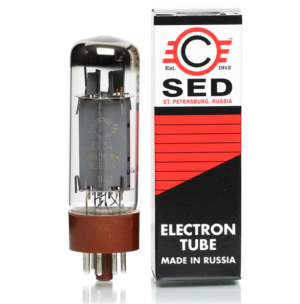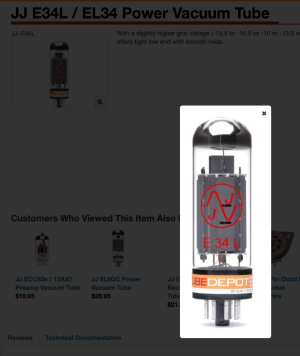Back in the day, tubes were made better. The machines the parts were made with were properly maintained and new. Allow me to explain further, since I took a ridiculously deep dive into this in the '00s when I started using NOS tubes.
To a degree, there's a mechanical component to the manufacture of tubes.
First, they work most efficiently when the metal parts inside the tube are properly made with proper alignment between anode and cathode (the electrons jump from cathode to the anode and are amplified) well coated, wired, etc. There is a grid that gets the voltage and controls how fast the electrons move between the anode and cathode. It's made of a wire material. The getter and glass coatings are designed to absorb the gases that are emitted. The spacer design that keeps the parts from the glass, with multiple 'fingers' to prevent mechanical ringing, proper vacuum, etc., matters.
How these parts are put together makes a difference. They need to be correctly spaced and aligned. That takes (a) good machinery and metal quality, and (b) correct assembly by the hand-workers.
What you don't want is for the tube to mechanically ring when it's subjected to vibration, because to a degree all tubes will vibrate. The tubes in a guitar amp obviously are either subject to torture inside a combo amp, or sitting on a speaker cabinet in the case of a head, and they will still vibrate sympathetically to the volume a guitar cab puts out. You can hear this, since even a good tube is slightly microphonic. Nature of the beast.
When tube manufacture stopped here in the late '70s, the machines were sold to manufacturers in other countries. The machines that were made in the UK and Europe were sold to Eastern Europe and Russia.
Those machines are still in use, and as you can imagine, they are very old. If new parts were/are made, they weren't made by the original manufacturer of the machine. Tolerances are not the same.
The parts were assembled by hand, by trained personnel, before being put into the glass envelopes.
There were trade secrets to tube manufacture, and the people designing the tubes and machines began their experience at the dawn of the tube age (WW1 and after), and then there was a second generation trained by the first from the 1940s to the late seventies/early eighties. Most of those folks are no longer on the planet.
In other words, they knew what they were doing, had new machines that made things to proper tolerances, and the quality of assembly was much better.
I once had photos of NOS and new-manufacture tubes on Imgur that I could post. I no longer have the photos, but I can explain what was in them.
If you look at a high quality NOS tube, you see that the legs holding the plates upright are straight and parallel. They are often a thicker gauge than modern tubes. Even the wires are often thicker. The spacers had lots of fingers to reduce vibration between the glass and the innards.
If you look at modern tubes, you'll see the metal parts inside skewed, often bent, etc. I can't speak to the quality of the materials used, but it's clear that the legs are thinner, wires thinner, etc., on many modern tubes. Also clear is that the mica spacers are different; often there are fewer or no fingers holding the parts away from the glass.
So modern tubes tend to rattle when vibrated. In the '60s and '70s we NEVER had to resort to rubber rings around tubes to stop vibration, etc. Amps sounded the way the Great Gods of Tone intended! [BTW, the Eurotubes rings work if you have a problem with modern output tubes in a combo amp.]
So by and large you find that NOS tubes are less 'ringy' and harsh; the signal is simply amplified better for all the above reasons.
I spoke to one of the Mesa techs about tubes, and was told flat out, they can't find quality modern tubes, and what quality is there is getting worse and worse. He told me that he will not buy a combo amp because the tube quality is so low they can't make the tubes not rattle.
Final Thoughts About NOS
Installing NOS isn't going to make you go, "OMG, this is AMAZING!"
What they do is far more subtle: NOS tubes make owning the amp long-term more satisfying.
It turns off the merry-go-round and you find your amps are pretty wonderful and they're keepers. If you're a person who keeps all their gear regardless, installing NOS might make them sound even better to you in the long run.
I've installed NOS in all my amps (haven't done it yet with the Mark VII but will). Before going NOS, I was on the amp merry-go-round. After a relatively short while, I'd get a little antsy for something different.
Since going fully NOS, I haven't sold or traded a single amplifier except the Mark V - and I only did that because I wasn't using two of the three channels (I'm more of an 'edge of breakup' player than a high gain person). My oldest amp will be 12 years old early in 2026, and they range to 2019 for the last one I bought before the Mark VII a few months ago.
The only viable alternative to NOS I've found are cryogenically treated quality tubes - JJs qualify as they seem to be mechanically well made, though I haven't yet tried Psvane, that I hear are also trying hard to improve tube quality.
Cryogenics is something I thought was snake oil. Turns out it isn't. It's an industrial process that was developed by engineers at one of the universities near me, for the purpose of making metals more rigid; I'm in the Detroit area where metal cars and trucks got made). Obviously if you start with a decent tube, rigid parts are less susceptible to rattles and failure.
There's a US company that bought the Telefunken name, and they make very expensive microphones. Some are tube mics, so they select JJ tubes and have them cryo-treated. Their output tubes rattle and ring less than other new tubes, and sound pretty darn good. They're what I use for the output tubes in my Fillmore (the rest of its tubes are NOS JAN-GE military grade tubes). I bought them as a temporary fix because I couldn't find the tubes I wanted, but they sound very good for modern 6L6s. Everything else uses NOS.
Note that the 'JAN' (joint army-navy, UK has another designation - CV I think) are production line tubes that simply tested well. Jet fighters had lots of tube gear for a long time because they were worried that transistors would be destroyed by radiation in nuclear explosions, and obviously they didn't want failure.
I like Siemens tubes because they were intended for critical use in the medical equipment Siemens made. I think, however, at least some of the tubes were made by UK (Mullard, Brimar, etc.), Netherlands (Philips, Bugle Boy etc.,) and later East German companies, and were labeled Siemens after testing.






